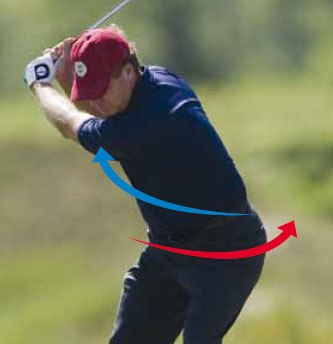
In last month’s issue we wrote about the physics and physiology behind generating optimal power and efficient movement in the golf swing. This month we’ll focus on physiology of the muscles and the laws of physics.
When we amateurs watch a professional golfer’s swing, we often marvel at how effortless the motion seems and how far the ball travels. Regardless of the size and shape of the professional golfer or his/her personal style, the swing we see — and the ball flight — is something all amateurs endlessly strive to achieve.
What most of us don’t realise is that one of the primary reasons the golf professional is so proficient is that his/her body works in complete coordination, optimizing the physiology of the muscles and the laws of physics. Underneath all the variances we see from swing to swing, each professional optimizes his/her kinetic link.
How power is generated in the golf swing is a combination of two things: 1) Conservation of momentum and 2) Muscular loading. Muscular loading refers to the stretch-shorten effect of producing potential energy by pre-stretching (or eccentrically firing) the muscles prior to shortening. This stretch-shorten action creates potential energy which is then used to enhance the muscular contraction.
During the kinetic link, this action plays two import roles: the first is to provide more energy to the muscular contraction that will accelerate body segments, and the second is to act to decelerate the heavier adjacent body segment in the Kinetic Link; thus facilitating “momentum transfer” at the lighter body segment next in the chain (for more on this, see The Biomechanics of Golf).
In order to effectively utilize both of these benefits, muscular loading or stretch-shorten must occur as a function of the bigger/heavier body segment accelerating while the lighter adjacent segment momentarily lags. The stretch occurs as a function of the resulting separation. Once the muscles begin to shorten the potential energy created in the eccentric stretch is then used to enhance the contraction, which in turn accelerates the lighter segment. AND at the same time this action decelerates the heavier segment facilitating “momentum transfer” to the lighter segment and promoting segmental summation of speed.
Applying this to your golf swing
How this applies in the golf swing is on the downswing: the hips generate anti-clockwise acceleration around the axis of the spine towards impact, creating dynamic loading of the muscles of the upper body. These muscles are stretched, creating energy that is then used to transfer energy to the shoulder segment. The shoulder segment then follows the lead of the hips in an anti-clockwise motion. At this time the hip segment begins to decelerate. This action “passes” energy as the muscles of the upper body contract to accelerate the shoulder segment. The result is the creation of power and rotational speed of the shoulders which is twice that of the hips.
The same applies for the upper body and arms; the muscles in the arms and lats are stretched, creating energy that is then used to transfer energy to the arms. The arms begin to follow the lead of the upper body anti-clockwise. At this time the upper body begins to decelerate. This action “passes” energy as the muscles of lats and arms contract to accelerate the arms into impact. The result is creation of power and speed of the arms which is double that of the hips. Finally, the club is “released” by the acceleration-deceleration action of the arms creating maximum rotational and linear club head speed at impact.




![Win the golfing experience of a lifetime, at the Hawai‘i International Week of Golf, valued at $6,900 [Winner Announced] Win the golfing experience of a lifetime, at the Hawai‘i International Week of Golf, valued at $6,900 [Winner Announced]](https://www.insidegolf.com.au/wp-content/uploads/Hawaii-Comp-500x294.jpg)